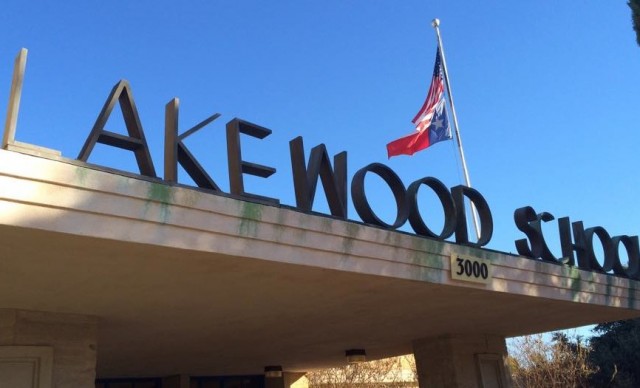
Photo from Facebook
The Dallas ISD board of trustees will vote tonight on a $134.7 million “bridge plan” proposed by district administrators. Several neighborhood schools stand to gain facility renovations and additions from the vote, including Dan D. Rogers, Sanger, Stonewall and Lakewood elementary schools.
Rogers and Sanger are on the list as future DISD “schools of choice,” with $2.5 million to turn Rogers into a “personalized learning innovation school” and $700,000 to replace Sanger’s pre-k modulars with a wing and add modulars at the school to expand Sanger up to eighth-grade. Stonewall and Lakewood are on the list as “high-need” facilities because of campus overcrowding and poor facility conditions, with $5.3 million and $12.6 million, respectively, to address needs at both schools.
The funds would be used to build new classrooms at each campus, replacing decades-old portable buildings (15 at Stonewall, 14 at Lakewood) and modulars (two at Lakewood). Stonewall is over capacity by 222 students, Lakewood is over capacity by 303 students.
But why does it cost $12.6 million to build classroom space for 300 students at Lakewood and only $5.3 million for 200 students at Stonewall?
On the face of things, it looks like Lakewood is getting a preferential deal. For the other seven* schools in the “high-need” category, the proposed square footage being added per extra student ranges from 53 (Seagoville and W.T. White high schools) to 70 (Tom Field elementary school). Lakewood, by contrast, would be adding 144 square feet per extra student.
Why the disparity? A couple of reasons, DISD officials say. First, Lakewood is the only school on the high-need list that includes modulars, which were installed in 1975 and “arguably in worse shape than the portables,” says DISD chief of transformation and innovation Mike Koprowski, citing the June 2013 Parsons facility study commissioned by the school district. Those modulars can hold roughly 250 students, which is included in the overall school capacity of 552. Without the modulars, Lakewood’s capacity drops to 302 students, meaning 553 more students attend Lakewood than the school has room for.
In this scenario, the square feet per extra student drops to 79 — much lower than 144 square feet, but still higher than any other school on the high-need list. The reason? Lakewood also is the only school on the high-need list receiving a new cafeteria and library as part of the bridge plan, accounting for roughly 10,000 of the square footage and $3.3 million of the cost.
The Lakewood addition described in the bridge plan — 26 new classrooms plus a library and cafeteria — is similar to the Lakewood Elementary Expansion Fund‘s conceptual plan for a new addition and renovations. LEEF estimated this would cost $15 million and originally planned to raise this money via community and corporate donations as well as grants and DISD matching funds. LEEF did successfully raise $500,000 from the community for architectural drawings, but its other fundraising goals haven’t panned out. Now, with Lakewood ranked no. 7 on the district’s high-needs list (Stonewall is no. 5), it seems as though the district may fund the whole kit and kaboodle.
Koprowski notes that, in the long term, new cafeterias, libraries and other communal spaces also will need to be considered for the other high-need campuses as well as all Dallas ISD campuses. But Lakewood is unique, he says, because “in order to actually build the new wings, there’s a strong chance we would have to renovate the cafeteria no matter what.”
DISD chief of operations Wanda Paul adds that “Lakewood’s site is very restrictive, so we have to look within a current footprint to try to reapportion the number of kids they have there.” Not to mention that Lakewood currently has five or six lunch periods, she adds, “because the capacity is so many kids over enrollment. Literally as soon as a kid gets off a bus, about 10 [a.m.], the school starts serving lunch.”
“Obviously we have a lot of needs,” Paul continues, and DISD plans to address the many other facility needs in the near future by presenting a funding plan to voters. In the interim, she says, “whatever we can do under the bridge plan is positive.”
Considering how large the Lakewood addition would be, the cost per square foot — roughly $275 — is considerably lower than the other seven schools, which range between $332 (Macon Elementary) to $528 (Seagoville High School). Lakewood parent and LEEF spokeswoman Amy Fennegan says that $12.6 million would not be enough to construct the entire project LEEF envisioned. “We’re already putting our hat in the ring for bond money, and looking at other donors is not off the table. But with the $12.6 million and our $500,000, we can definitely get started.”
Paul says that if the board approves the bridge plan tonight, it will give architects a green light to begin working on these projects “immediately.” The plan could be voted down, however, as well as amended, so plenty of Lakewood and Stonewall parents plan to attend tonight to help make sure that doesn’t happen.
The board meeting is looking to be a long one — already, 40 speakers have signed up, and with three minutes each to make their case to the board, trustees may be listening for two hours before they even start debating the 20-plus items on the consent agenda. The bridge plan is no. 20.
* Greiner Middle School, also in the district’s high-need category, was not included in these calculations because the funding would go only toward the school’s roof. Funds from the 2008 bond package are currently being used toward an addition at Greiner.





